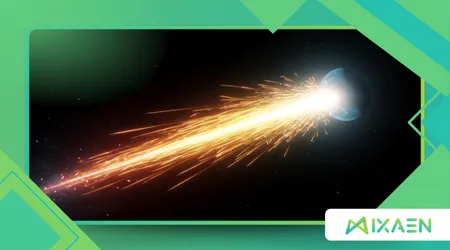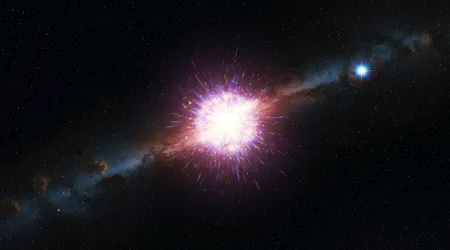Fast Radio Bursts: Mysterious Signals from the Deep Universe

Fast radio bursts, fleeting pulses of cosmic energy, captivate astronomers with their enigmatic origins.
Anúncios
These millisecond-long flashes, first detected in 2007, outshine entire galaxies in an instant, yet their sources remain elusive.
As we venture into 2025, the quest to unravel these cosmic riddles intensifies, blending cutting-edge technology with human curiosity.
This article dives into the heart of fast radio bursts, exploring their discovery, potential causes, and the tantalizing clues they offer about the universe’s hidden mechanics.
Why do these signals, traveling billions of light-years, spark such fascination? Let’s embark on a journey through the cosmos to find out.
The allure of fast radio bursts lies in their unpredictability and power. They challenge our understanding of astrophysics, pushing scientists to rethink stellar phenomena.
From neutron stars to distant galaxies, the theories are as diverse as the universe itself. Recent advancements, like the CHIME telescope’s real-time detection, have brought us closer to answers.
This exploration not only highlights the science but also the human drive to decode the unknown, making fast radio bursts a beacon of cosmic mystery.
The Discovery of Fast Radio Bursts
In 2007, astronomers stumbled upon a peculiar signal in archived radio telescope data. Duncan Lorimer’s team at West Virginia University noticed a millisecond-long burst, now dubbed the “Lorimer Burst.”
It was a singular event, radiating energy equivalent to the Sun’s output over a year. This discovery, published in Science, marked the birth of fast radio burst research, igniting global interest.
The signal’s brevity and intensity baffled researchers. Unlike pulsars, which emit rhythmic pulses, this was a one-off explosion from an unknown source.
++ The Missing Antimatter Problem: Where Did It All Go?
Its high dispersion measure suggested an extragalactic origin, billions of light-years away. The astronomical community buzzed with questions, as no known phenomenon fully explained it.
Subsequent detections confirmed fast radio bursts weren’t flukes. By 2025, hundreds have been cataloged, some repeating, others singular.
The Canadian Hydrogen Intensity Mapping Experiment (CHIME) has been pivotal, detecting bursts in real-time, transforming our approach to studying these cosmic flashes.

What Are Fast Radio Bursts?
Fast radio bursts are intense, brief radio wave emissions, lasting mere milliseconds. They carry immense energy, sometimes outshining entire galaxies in a fleeting moment.
Their origins are traced to distant cosmic sources, often billions of light-years away, based on their dispersion patterns.
These bursts exhibit a unique “sweep” in frequency, with higher frequencies arriving before lower ones. This dispersion, caused by interstellar electrons, helps estimate their travel distance.
Most are extragalactic, though some, like a 2020 burst, originated within the Milky Way.
Also read: Is the Speed of Light Really Constant Across the Universe?
Their unpredictability adds to the challenge. Some repeat, like FRB 121102, pulsing intermittently from a distant galaxy. Others are one-time events, vanishing without a trace.
This diversity fuels speculation about their causes, from natural phenomena to speculative extraterrestrial signals.
Theories Behind Their Origins
What sparks fast radio bursts? Theories abound, each grounded in astrophysical phenomena.
Neutron stars, particularly magnetars with intense magnetic fields, are leading candidates. Their rapid spins or magnetic flares could unleash powerful radio waves.
In 2025, a burst traced to a Milky Way magnetar strengthened this hypothesis. Yet, not all bursts fit this model.
Some originate from “cosmic graveyards” dead galaxies with ancient stars challenging neutron star theories. Could colliding black holes or exotic events like cosmic strings be culprits?
Another theory explores binary systems. A 2025 study of ILTJ1101 revealed two stars with interacting magnetic fields producing long-period transients.
Read more: Time and Gravity: How Mass Warps the Fabric of Spacetime
This suggests fast radio bursts may have diverse origins, each offering a piece of the cosmic puzzle.
The extraterrestrial intelligence hypothesis, while intriguing, remains speculative.
The Search for Extraterrestrial Intelligence (SETI) examines bursts for artificial patterns, but natural explanations dominate. Each theory, from magnetars to mergers, pushes us to rethink the universe’s dynamics.
Technological Advances in Detection
Unraveling fast radio bursts demands cutting-edge technology. The CHIME telescope, with its real-time detection, has revolutionized FRB research by capturing bursts as they occur.
Its sensitivity has cataloged hundreds of bursts since 2018.
The Australian Square Kilometre Array Pathfinder (ASKAP) excels at pinpointing burst origins. In 2022, it traced a burst to a “blob-like” galaxy cluster 8 billion light-years away.
Combined with the Hubble Space Telescope, these tools refine our cosmic map.
The CRACO system, launched in 2025, processes 100 billion pixels per second, sifting through cosmic noise for fleeting signals.
This technology, likened to finding a coin on a beach, enhances our ability to study fast radio bursts in unprecedented detail.
Cosmic Implications and Insights
Fast radio bursts are more than cosmic curiosities; they’re tools for understanding the universe. Their dispersion measures map the intergalactic medium, revealing the distribution of cosmic matter.
A 2025 study used 92 bursts to constrain the baryon fraction in the intergalactic medium.
They also probe extreme physics. Bursts from magnetars or black hole mergers offer glimpses into high-energy environments.
Their signals, traveling billions of years, carry clues about the universe’s early conditions, acting like cosmic time capsules.
Imagine fast radio bursts as lighthouses in the cosmic ocean, guiding us through uncharted waters.
Their study could unlock secrets about galaxy formation, dark matter, or even the universe’s expansion. Each burst is a snapshot of cosmic history, waiting to be decoded.
Challenges in FRB Research

Despite progress, studying fast radio bursts is fraught with challenges.
Their fleeting nature demands rapid detection, as most vanish before follow-up observations. Even repeaters, like FRB 20240209A, are erratic, complicating analysis.
Pinpointing origins is another hurdle. While ASKAP and CHIME excel, many bursts lack precise locations, hindering source identification. The vast distances involved add complexity, as signals weaken over billions of light-years.
Interpreting data requires ruling out terrestrial interference, like microwave ovens, which once mimicked bursts.
Sorting cosmic signals from noise demands sophisticated algorithms and relentless skepticism, ensuring we chase truth, not illusions.
Table: Key Fast Radio Burst Discoveries (2007–2025)
| Year | Event | Source/Location | Significance |
|---|---|---|---|
| 2007 | Lorimer Burst | Unknown, extragalactic | First fast radio burst detected |
| 2012 | FRB 121102 | Distant galaxy | First repeating burst identified |
| 2020 | Galactic FRB | Milky Way magnetar | Linked bursts to neutron stars |
| 2022 | FRB 20220610A | Galaxy cluster, 8 billion light-years | Most distant burst traced |
| 2025 | ILTJ1101 | Binary star system | New source type discovered |
The Future of FRB Research
What lies ahead for fast radio bursts? Next-generation telescopes, like the Square Kilometre Array, promise higher resolution and more detections.
These tools could pinpoint burst sources with unprecedented accuracy, narrowing down theories.
Artificial intelligence is transforming FRB research. The SETI Institute’s COSMIC system, using NVIDIA’s Holoscan, detects bursts in nanoseconds, enhancing real-time analysis. This could reveal subtle patterns in burst behavior.
Collaboration is key. Global networks of telescopes, sharing data instantly, will accelerate discoveries. By 2030, we may unravel whether fast radio bursts stem from a single phenomenon or diverse cosmic events, reshaping astrophysics.
A Cosmic Puzzle Worth Solving
The enigma of fast radio bursts captivates us because it’s a mystery that spans the universe. Each burst is a whisper from distant stars, carrying secrets of cosmic processes.
Their study blends technology, curiosity, and the thrill of the unknown, pushing humanity to explore further.
As we stand in 2025, fast radio bursts remind us how little we know about the cosmos. They challenge our assumptions, from stellar evolution to the possibility of life beyond Earth.
Will we ever fully decode these signals? Only time, and relentless exploration, will tell.
This journey is a testament to human ingenuity. From a single burst in 2007 to thousands detected today, we’ve turned fleeting signals into a window on the universe.
Fast radio bursts are not just phenomena; they’re invitations to wonder, question, and discover.
Frequently Asked Questions
What causes fast radio bursts?
They may originate from neutron stars, magnetars, or binary systems, but diverse sources suggest multiple mechanisms. Exact causes remain under investigation.
Are fast radio bursts signs of alien life?
While SETI explores this, natural explanations like magnetars are more likely. No artificial patterns have been confirmed in bursts.
How are fast radio bursts detected?
Radio telescopes like CHIME and ASKAP capture their millisecond-long signals, with AI systems like CRACO enhancing real-time detection.
Example 1: The Cosmic Symphony
Picture a burst as a note in a cosmic symphony. FRB 121102, repeating from a distant galaxy, is like a persistent melody, hinting at a magnetar’s rhythm.
Example 2: The Galactic Firework
A 2020 Milky Way burst was like a firework in our backyard. Its magnetar source confirmed neutron stars as one origin, sparking new questions.
Statistic: Over 1,000 fast radio bursts have been detected by 2025, with CHIME alone identifying hundreds since 2018.
Analogy: Fast radio bursts are like cosmic postcards, sent from distant stars, arriving with messages we’re only beginning to read.
